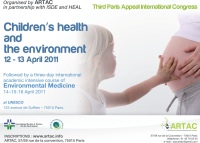- you are on : Environmental Medicine
- Practice of environmental medicine
Practice of environmental medicine
From a strictly medical viewpoint, services rendered by environmental medicine are huge, as it consists of removing the causes of very expensive diseases or afflictions , and it uses strict scientific objectivity to improve the detection of early biological signs, when still reversible, before they become more clinically visible yet often irreversible lesions. That means that the objective of environmental medicine is to diagnose diseases before their true clinical appearance in order to avoid them by implementing prophylaxis and more particularly by creating adequate individual protective measures. By the time clinical symptoms have appeared and if it is not too late, the objective becomes to treat the patients according to observed frank poisoning signs, and reveal the upstream physio-pathological mechanisms.
The scientific approaches of environmental medicine are based on the following medico-biological developing fields: the development of (1) new medical imaging techniques and (2) objective biological tests measuring biomarkers related to the environment, such as heat shock proteins and early inflammation biomarkers ; (3) different immunological investigations making it possible to distinguish fundamentally allergies from pseudo-allergies ; (4) the study of the epigenome and that of the genetic polymorphism mapping to detect objectively as early as possible a particular susceptibility to certain pollutants; (5) the detection of a toxic impregnation in the body by metals; (6) the determination of early biological signs of chronic inflammation and oxidative stress; and finally (7) The use of specific tests proving a causal link between symptoms and the environment. All these tests and methods are major assets to make a diagnosis of environmental diseases and to treat patients before the clinico-biological abnormalities detected by conventional medicine become irreversible. Thus, thanks to the implementation of (1) an early chemo-prevention, including correction of potential vitamin and/or oligo element deficiencies ; (2) the early use of adequate anti-inflammatory ; (3) of antihistamines and/or (4) of suitable antioxidants ; (5) the practice under strict medical control of detoxicating techniques in the case of organic metal or radioactive contamination. Patients that have fallen victims to pollution may be treated and avoid the onset of an irreversible disease or affliction, which unfortunately is often incurable despite standard medicine’s advances.
But today’s diagnosis and treatment standards would be insufficient were they not systematically combined with recommendations and personalized prevention and precaution measures, aimed at informing and protecting patients of environmentally-induced harm. This message is more particularly and essentially intended for pregnant women and children, due to the extreme biological vulnerability of foetus, newborns and infants.
